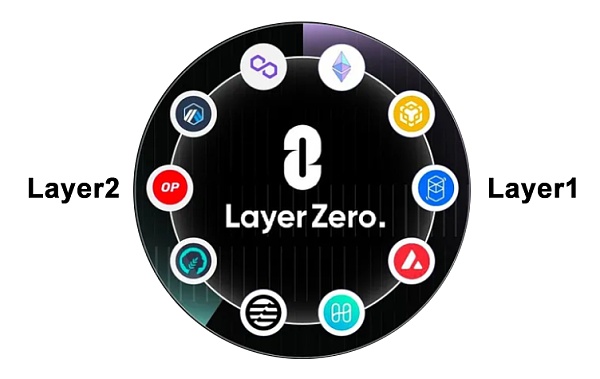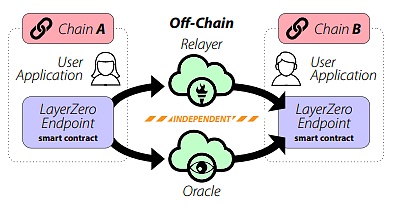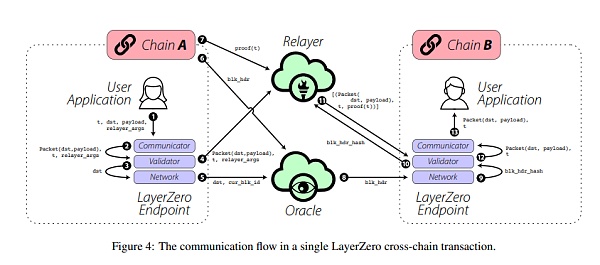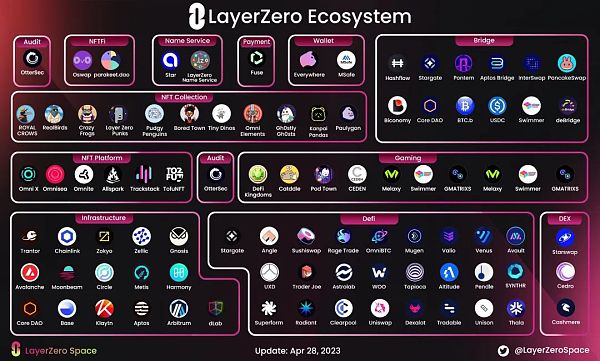Research Report on Interchain Operation Protocol LayerZero
Report on Interchain Ops Protocol LayerZeroTable of Contents
1. Project Introduction
2. Project Vision
3. Features and Advantages
- Introducing the important upgrade of MIM: the first Omnistable built on the OFT standard based on LayerZero.
- Which BRC20 projects can I actively participate in?
- First OrdiBots project with a thousand-fold increase? Understand the GBRC721 protocol with this article.
4. Development History
5. Team Background
6. Financing Information
7. Development Achievements
8. Economic Model
9. Risks and Opportunities
As DeFi projects gain popularity, cross-chain interoperability has become a hot topic in the blockchain industry. Among many cross-chain platforms, Layer Zero has attracted attention due to its innovative technology and design. This article will introduce the technology and characteristics of Layer Zero, as well as its current expanding ecosystem.
1. Project Introduction
LayerZero is a trustless full-chain interoperability protocol, serving as a communication platform between blockchains. It is designed for the lightweight transmission of information across chains, providing true and guaranteed message delivery through configurable trustlessness. LayerZero provides a powerful underlying communication network structure, where various cross-chain application sets can be built on top of it, breaking the isolation between blockchains. For developers, LayerZero enables seamless linking of applications, eliminating barriers between different blockchains and achieving efficient and accurate information exchange. For users, it allows transactions to take place across different chains, improving liquidity.
2. Project Vision
LayerZero is not simply a cross-chain asset bridge, but rather a more fundamental infrastructure protocol than L1 public chains, doing more upper-layer message cross-chain to break the isolation between chains. LayerZero aims to build a more diverse cross-chain ecosystem based on the LayerZero protocol, providing a network infrastructure and message transmission layer for the entire chain ecology. Currently, representative products built on LayerZero include Stargate and Radiant. With the continued development of the LayerZero ecosystem, it is expected that more native cross-chain products based on the LayerZero protocol will emerge in the future.

3. Features and Advantages
1. Features
The most prominent feature of LayerZero is its ultra-lightweight nodes. Utilizing ultra-lightweight node technology, messages are transmitted between endpoints of different chains through relays and oracles, reducing costs while ensuring security.
(1) Super Light Node
First of all, each node in a blockchain network is actually a computer or server terminal that stores data. A light node is just a mode of operation of a node. Unlike a full node, a light node only stores a small portion of the blockchain data, such as block headers and other information, and does not store specific transaction information within the block. So compared to a light node, a super light node has the same verification method as a light node on the chain, but does not retain all block headers. Instead, it uses an oracle to transmit streaming block headers on demand, making it more efficient to synchronize with external entities to achieve the desired state.
(2) Core Components of LayerZero
According to the LayerZero white paper, there are two core components of LayerZero, namely the oracle and the relayer.

The oracle is a third-party service that provides a mechanism component independent of other LayerZero, which can read a block header from one chain and send it to another chain, so as to verify the validity of transactions on the source chain on the target chain. LayerZero uses Chainlink as its oracle.
The relayer is an off-chain service that is functionally similar to the oracle, but instead of getting block headers, it gets proofs of specified transactions. To ensure effective delivery, the only requirement is that for any given message sent using the LayerZero protocol, the oracle and the relayer must be independent of each other. LayerZero can even implement its own relay service. This design allows users to determine that the relayer cannot collude with the oracle, and this independence allows LayerZero to achieve trustless verification delivery.
The block header submitted by the oracle will be cross-verified with the transaction proof submitted by the relayer, and there will be no consensus between the two, only message transmission. In short, the oracle acts as a notary role in the LayerZero cross-chain, letting the target chain know how the verification results are, while the relayer is responsible for providing the proof process required to verify the transaction and the specific content of the cross-chain information.
(3) Operating Mode

According to the LayerZero white paper, when a cross-chain message needs to be transmitted (for example, from Chain A to Chain B), the LayerZeroEndpoint smart contract needs to be called first. The super light node on Chain A receives this task and packs the message (transaction proof and block header) and information to be sent to Chain B, respectively, to remind the off-chain oracle and relayer. Here, the oracle and the relayer are independent of each other, and in the off-chain, the two cannot collude with each other. The oracle obtains block header information, and the relayer obtains transaction proof. When the super light node on Chain B receives the block header message from the oracle, the relayer submits the corresponding transaction proof again. Only when the block header message and the proof message match, the real message content will be sent to Chain B to complete cross-chain communication.
Both the oracle and relay can be customized, and users can only use LayerZero’s light node, and then use relays different from LayerZero and oracles different from Chainlink.
2. Advantages
(1) Security
As a underlying protocol, the security of LayerZero is independent of external protocols, ensuring the stability of the entire protocol consensus. In addition, thanks to the unique design of the oracle and relay, the oracle and relay are independent of each other, and the transaction is only completed when both are considered true, ensuring the security of information transmission.
(2) Scalability
LayerZero, as a general message passing layer, means that any contract can be transferred from Chain A to Chain B to achieve cross-chain interoperability with L1. Through innovative endpoint design, LayerZero can easily be expanded to support any chain, bringing a wider range of application scenarios to the blockchain ecosystem.
(3) Efficiency
First, LayerZero’s ultra-light node technology can achieve higher transmission efficiency and reduce verification costs while ensuring security. Secondly, the relay or oracle of LayerZero does not form any consensus, only simply transmitting messages, and all verifications are completed on their own target chain, so the speed and throughput restrictions are entirely dependent on the attributes of the two transaction chains.
4. Development history
2021.05.26 LayerZero white paper released
2022.03.15 Invited 0xmaki, former founder of SushiSwap, to join the team
2022.03.17 LayerZero’s cross-chain protocol Stargate token $STG sale (100 million, accounting for 10% of the total issuance of STG, after the auction, 100 million STG will be locked for 12 months, and then unlocked linearly in 6 months)
2022.03.18 Stargate mainnet launched
2022.08.11 Decentralized stablecoin protocol Angle Protocol integrated with LayerZero, enabling its euro stablecoin agEUR to be transferred across Ethereum, Polygon, Optimism, and Arbitrum.
2022.09.07 LayerZero launched the full-chain block explorer LayerZero Scan
2022.11.20 LayerZero launched on Metis Goerli testnet
2022.12.01 LayerZero integrates with Chainlink Oracle
2023.02.06 Trade Joe integrates with LayerZero, and the Joe native token will become a full-chain token
2023.03.10 LayerZero Labs announces deployment on Coinbase Ethereum Layer2 network Base, and LayerZero’s endpoint contract has been deployed to the testnet
5. Team Background
LayerZero Labs was founded in 2021, and according to LinkedIn, it currently has 55 members (including part-time employees). The founding team members are as follows:
Ryan Zarick: Co-founder and CTO of LayerZero Labs, with a master’s degree in computer science from the University of New Hampshire in the United States. From November 2011 to March 2013, he served as CTO of BuzzDraft; from September 2010 to January 2020, he served as co-founder of Coder Den; from January 2018 to March 2020, he served as co-founder of 80Trill; from June 2019 to January 2021, he served as co-founder of Minimal AI; and in 2021, he founded LayerZero and serves as CTO.
Bryan Pellegrino: Co-founder and CEO of LayerZero Labs, with a bachelor’s degree in computer science from the University of New Hampshire in the United States. From October 2010 to January 2013, he served as co-founder and COO of Coder Den; from June 2011 to January 2013, he served as CEO of BuzzDraft; from October 2017 to August 2019, he served as co-founder of OpenToken; from June 2016 to present, he has been the chief engineer of Rho AI; and in 2021, he founded LayerZero. Prior to founding LayerZero, Pellegrino was a professional poker player and co-founded a machine learning company with Ryan Zarick, successfully selling a set of machine learning tools to an MLB team.
Caleb Banister: Founder of LayerZero Labs, with a bachelor’s degree in computer science from the University of New Hampshire in the United States. From June 2005 to December 2010, he served as a software developer at the UNH Interoperability Lab; from September 2010 to February 2021, he served as co-founder of Coder Den; from March 2018 to February 2021, he served as co-founder of 80Trill; from June 2019 to February 2021, he served as co-founder of Minimal AI; and in 2021, he founded LayerZero.
From the resumes of the three co-founders of LayerZero Labs, the team has outstanding innovation capabilities in machine learning algorithms and blockchain development, and they have a long-term cooperative relationship and many years of development and successful entrepreneurship experience.
Additionally, 0xmaki, co-founder of Sushiswap, has joined the team as Chief Strategy Officer, helping to build Layerzero’s cross-chain ecosystem.
Sixth, Financing Information
In April 2021, LayerZero Labs raised $2 million in seed funding.
In September 2021, LayerZero Labs completed a $6.3 million Series A funding round led by Multicoin and Binance Labs, with participation from Sino Global Capital, Defiance, Delphi Digital, Robot Ventures, SBlockingrtan, Hypersphere Ventures, Protocol Ventures, Gen Block Capital, and others.
In March 2022, LayerZero Labs completed a $135 million Series A+ funding round at a valuation of $1 billion, co-led by a16z, FTX Ventures, and Sequoia Capital, with participation from Coinbase Ventures, BlockingyBlockingl Ventures, Tiger Global, and Uniswap Labs, among others. (In November 2022, LayerZero announced that it had bought back 100% of the equity, coin rights, and any other agreements from FTX/FTX Ventures/Alameda Research.)
In April 2023, LayerZero Labs completed a $120 million Series B funding round at a valuation of $3 billion, with participation from a16z Crypto, Christie’s, Sequoia Capital, Samsung Next, BOND, Circle Ventures, and OpenSea Ventures, among others.
As can be seen, LayerZero has received the favor of many large capital parties from the beginning. As of now, it has raised a total of $263 million in financing, with sufficient project funds to support the advancement of technological products and ensure the long-term development and operation of the project.
Seventh, Development Achievements
As a full-chain interoperability protocol that achieves cross-chain state sharing, lending, governance, etc., LayerZero currently supports a total of more than 30 chains, including Ethereum, BNB Chain, Avalanche, Aptos, Polygon, Arbitrum, Optimism, Fantom, etc. The LayerZero ecosystem is rapidly expanding, and has made significant progress in the areas of Defi, NFT, and cross-chain bridges. Specifically:

Cross-chain bridge: The previous cross-chain mode was locking and minting, that is, locking the native token in the designated smart contract of the original chain, and minting a new token on the target chain. This cross-chain bridge method is mainly used for token transfer, but it depends on network verification nodes. If the nodes behave maliciously or are controlled by hackers, it will cause serious losses, and cannot send native assets on different chains. The LayerZero ecosystem’s cross-chain bridge Stargate can realize seamless bridging of transactions on the chain. As the first dAPP built on Layerzero, Stargate overcomes the three dilemmas of cross-chain instant fund locking, unified liquidity, and native assets, thus linking the capital liquidity islands of various public chains and improving capital efficiency.
One of the major issues with DeFi is the lack of liquidity, which LayerZero can solve by enabling inter-chain operability. Developers can build DEX or other DeFi applications on specific chains, and for users, using LayerZero means they can stay on their original chain while accessing liquidity mining from other targeted chains through any DEX or aggregator.
As the first fully chain-based NFT, Gh0sts enables multi-chain issuance and atomic-level cross-chain transfer between multiple chains. LayerZero enables NFTs to move across chains without the need to start a new project on each chain, which would otherwise split the user base.
Eight, Economic Model
LayerZero has not yet issued a token.
Nine, Risks and Opportunities
(1) Risks
LayerZero’s security has not been fully verified, and there are still uncertain trust assumptions between oracles and relayers. Security risks behind the relay mechanism still need to be addressed, particularly regarding how to achieve decentralized relaying. Additionally, LayerZero outsources the task of verifying on-chain information to third parties such as Chainlink, which may result in uncontrollable security issues and increase potential risks and uncertainties.
Furthermore, LayerZero has not yet issued tokens, and it is uncertain how the economic model and token value capture ability will be after the project issues tokens.
(2) Opportunities
With the development of blockchain, interoperability between chains has become extremely important. Secure and efficient interaction between chains is crucial, and as a fundamental protocol, LayerZero differs from current cross-chain bridge projects on the market. By using super-light node technology and choosing an oracle network instead of traditional cross-chain continuous streaming transmission, the protocol is more flexible and cost-effective. Currently, LayerZero has connected to more than 30 chains and is widely used in various ecosystems. With the advent of multi-chain coexistence, LayerZero will have a first-mover advantage and contribute to the development of the blockchain ecosystem.
References:
https://layerzero.network/pdf/LayerZero_WhiteBlockingper_Release.pdf
https://www.web3sj.com/project/58557/
https://www.sohu.com/a/593455455_121118710
We will continue to update Blocking; if you have any questions or suggestions, please contact us!
Was this article helpful?
93 out of 132 found this helpful
Related articles
- Explaining the GBRC721 protocol and its ecosystem projects that have been boosted by OrdiBots’ thousand-fold increase
- What are the backgrounds of these 27 projects that received investments from top crypto VCs in April?
- Listing 5 Catalyst Projects / Narrative: Level Finance, Metavault, Lybra Finance…
- Hong Kong’s new crypto policy is about to take effect. Here are 6 crypto projects worth investing in:
- How can blockchain projects legally raise funds?
- Quickly review 5 LSDFi projects worth paying attention to recently: Swell, unshETH, Pendle, Gravita Protocol, and Blockingrallax Finance.
- Is it worth buying The Llamas, an NFT project in the Curve ecosystem?






